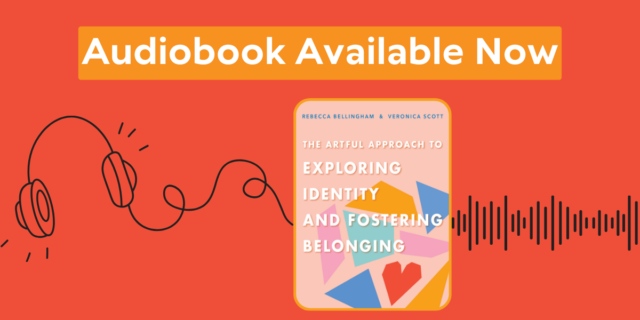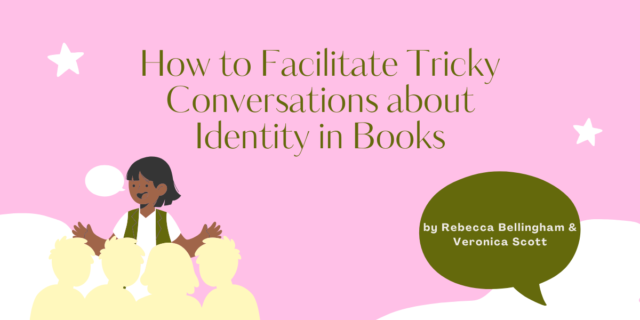
While poetry may seem complicated, it’s one of the easiest ways to dive into identity work with young people. Poetry is easy to find. Poetry sets a tone. Poetry is lyrical, rhythmic, and creates a space for movement. Poetry can serve a big need in a short time. Poetry gives you a chance to start small, which can make it a more invitational literary art form than an essay or even a free-write. And because poetry is meant to be read aloud, it’s inevitably an opportunity to express ourselves and share our stories in community with each other. In even the briefest bit of time, poetry connects us all.
When asked about why she chose to cowrite her book Born on the Water (Hannah-Jones and Watson 2021) in verse, Renée Watson said that poems can act as “containers for young people to process their emotions . . . each poem kinda acts as a small vignette so you can pause and kinda breathe through . . . and take it in bite size pieces. . . . ” (Pulitzer Center 2022). While this is certainly true for the experience of reading and sharing Born on the Water, we find this to be true about poetry in general. Poems can act as containers for all sorts of complex conversations and content, whether that be marveling at the vastness of our universe, grappling with hard history, or navigating friendship troubles in third grade. As a rhythmic art form, poems have the pauses and breaths built in. We can use those pauses to remind ourselves to slow down, listen more carefully, and reflect little by little, line by line.
Because of their brevity, poems make it easier for students to express themselves without the pressure of writing a perfect paragraph or an entire essay. In the same way that pauses can serve us well, refrains are also a common element in poetry that signal to us look again. They’re an invitation to think, see, and make meaning in new ways every time they appear. Refrains remind us that even the smallest thing contains multitudes— one line, one phrase, one word can be—just like us—many things.
Where to Find a Poem
While we have several books of poetry collections that we return to frequently, most of the time we collect poems in other ways. Here are a few suggestions for finding poetry that is both fresh and responsive to your needs:
- Picture books are often written as poems! We often type up the words of a picture book to create a poem that can be used to inspire children to write their own. Be on the lookout for picture books that have a repeating refrain or only a line or two per page and allow it to inspire you to create a prompt or invitation for your own students. Some of our favorite picture books that read like poems are: You Matter by Christian Robinson (2020), Love by Matt de la Peña (2018), Fry Bread by Kevin Maillard (2019), and Autumn Peltier, Water Warrior by Carole Lindstrom (2023).
- Songs are also written as poems! Study a song, even just a refrain, that might spark an idea, conversation, or an invitation for writing.
- Books told in verse have scores of poems to use with young people, even if you don’t read the whole book aloud, or use the whole book for a particular age group. We’ve used “Mami Works” from Elizabeth Acevedo’s book The Poet X (2018) to teach how precise action words can reveal so much about a person, which inspired our “Mountains We Climb” Women’s History Month project.
- Broaden your searches to include poems not written for kids! When we google “poems for kids,” we don’t often find a poem that suits our needs. Lots of times the poems that come up are limericks and rhyming poems, which are fabulous for fluency, vocabulary, morning meetings, and any number of important academic areas or daily moments. Most of the time we are looking to share something that invites deeper thinking about identity, or that offers us a lyrical phrase that we can use as a prompt or starting point to build upon creatively. Even just sharing an excerpt from a poem whose target audience is not young people, you will open possibilities for expression and connection that might be more inspiring or fruitful than if you just stick with poems tagged for children.
- Find a few voices that you love and whom you can return to again and again for inspiration. Some of our go-to authors and poets are Christian Robinson, Matt de la Peña, Jason Reynolds, and Joanna Ho. These writers are always producing new work and they all write poems that are intended for young people. We also love Joy Harjo, Mary Oliver, Naomi Shihab Nye, Nikki Giovanni, Clint Smith, and Aimee Nezhukumatathil, among others who don’t often or always write explicitly for children, but whose work can be used to elevate a conversation, a curricular unit, a cultural month, or even a community moment. We pay attention to what our faves are writing and we watch for other poets they lift up.
- There are several websites that we browse for ideas: Poetryfoundation.org, and poets.org are often categorized by BIPOC voices, cultural months, subject areas, and different times of year.
- Get to know your poet laureates! Even though we have a national poet laureate, states, and even some cities, have “poet laureates” too! This is a great way to get to know local voices in your area and learn about other poets who are writing and sharing new work.
- Look out the window: Poetry is all around us! As Ada Limón, one of our poet laureates, instructs young poets, “Don’t forget to look out the window and stare at things, because that’s where poetry happens” (Limón 2023).



